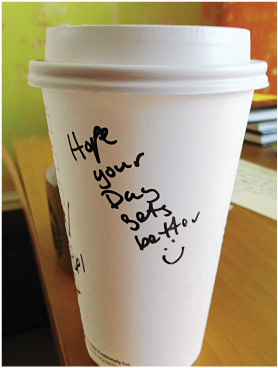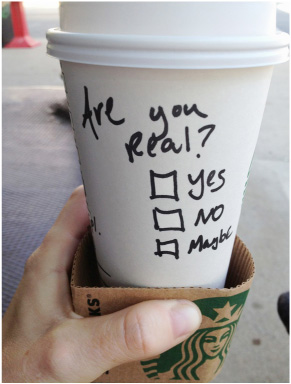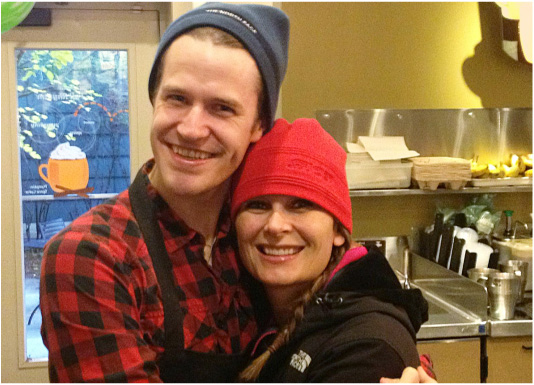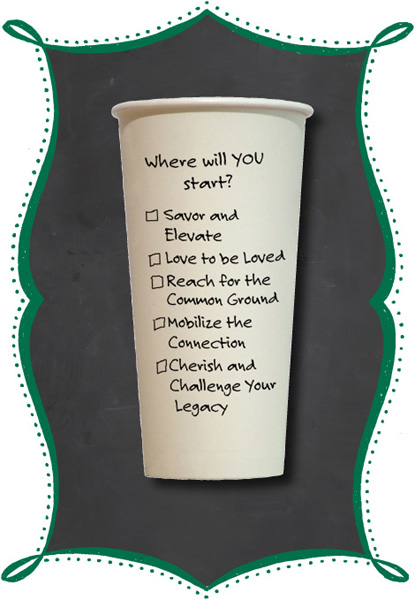
Forging a Real Lifestyle Connection


Take a moment and think about your ideal customers. Now imagine them waking up in the morning and using one of your products in their homes. On their way to work, they stop by your store, check in on Foursquare, open your app, and purchase an item with mobile payment. At the office, they take a break and encounter your products or go online to check their Facebook page and read a post of yours in their feed. During the afternoon, they sign up to participate with your team in a community improvement project on their day off. They invite their friends to participate in that event with them. They take pictures as they help their community and post those images on Instagram, Twitter, and Facebook. They use your products at the event. They stop at the supermarket on their way home, and your offerings are on their shopping list. Okay, it’s time to come back to reality.
It is important to remember that Starbucks started out as a single store and that anything is possible if we take the lessons learned from Starbucks as a nudge to think about how we can innovate and expand our products, services, social media tools, technologies, and channels. The leaders at Starbucks also demonstrate what is possible when you foster product passion, teach your people the importance of human connections, seek operational excellence and efficiency, and engage in a never-ending pursuit of relevance.
Howard Schultz puts it this way: “Any consumer brand today—whether Starbucks or a product like Tide—… [must] create relevancy in all aspects of your customers’ lives…. The price of admission is not good enough if your relevancy and market position is only where the product is sold. We said to ourselves that we have to be as relevant socially and digitally as we are when the customer is inside our four walls … companies that don’t understand [that] are going to [be] left behind.”
Traditionally, marketers talk about lifestyle brands as those that connect with customers’ personal identity. They are brands that “promote a lifestyle” customers value or to which they aspire. Starbucks is certainly a business that has all the traditional aspects of lifestyle branding, as its leaders have stewarded the brand to authentically project an image of product passion, concern for the human connection, and community values. However, Starbucks leaders have also taken their value proposition up a level to something I refer to as an “advanced lifestyle” brand. Not only does Starbucks “project a lifestyle,” but it enters the lifestyle of its customers.
Typically, Starbucks builds its connection with customers through its primary well-distributed channel: Starbucks retail stores. In fact, some research suggests that 80 percent of U.S. citizens live within 20 miles of a Starbucks store, and that the farthest anyone would have to travel to get to a Starbucks company-owned store is 140 miles (the study did not include licensed stores, so the distance may be even shorter). Once that connection is forged through the store channel, the leaders at Starbucks have positioned their brand to meet their customer on the go, whether that be on a mountaintop with VIA, in a health food store with Evolution Fresh juice, on a train in Switzerland, or through a mobile app in Beijing. Aimee Johnson, vice president, Digital Commerce, Loyalty and Content, notes, “We are committed to understanding our in-store customers and connecting to them in ways that fit both where and who they are!”
A proliferation of your brand certainly has risk. Reuben Gregg Brewer, director of digital content at Value Line, cautions that there are “material risks to Starbucks recent expansion efforts. While going global is a great idea, moving outside of one’s niche can, and often has, proven disastrous. Time and again new concepts in the quick service space flame out after coming to market…. Starbucks’ efforts could, indeed, result in a lack of focus…. Moving into additional distribution channels, Starbucks’ could risk oversaturation with its core brand and all of the others it has just added.”
Many partners with whom I have spoken report having confidence in Starbucks future based on the ability of the leadership to adapt and transform to changing customer needs. This confidence is not limited to those within Starbucks. Jim Cramer, bestselling author and television host of the popular CNBC program Mad Money, noted after the release of the Verismo system in 2012, “I am going with Schultz—not against him—because it has been a horrendous bet to go against Schultz in either the first or the second iteration and I think it will be a horrendous bet once again…. Schultz has primed Starbucks for a third round of growth and you don’t want to be caught outside looking in.” From my vantage point, success always hinges on high-quality products, provided the way customers want them, offered in a caring environment that builds connections. As long as Starbucks—or any business, for that matter—is achieving those objectives, customers will offer it their sustained support. While I imagine the leaders at Starbucks will continue to guide their brand wherever the opportunities and customers take them, I am certain that they will remind partners that the ultimate future of the brand depends on connecting in “uplifting moments.”
These moments are like those provided by Starbucks barista Daniel Rowe. Daniel had a relationship with a regular customer, Kelly Dietrich. On most occasions, Kelly would also order a Tall Nonfat Latte for his wife. As Daniel shares, “One day Kelly up-sized his wife’s nonfat latte to a grande. I figured she might need a little extra that day, so I wrote ‘Hope your day gets better’ on her cup.”

Kelly’s wife, Gini Dietrich, founder and CEO of Arment Dietrich, a Chicago-based integrated marketing communication firm, and coauthor of Marketing in the Round, notes, “The fact that the barista at Starbucks knew I was in for a long day because I ordered a larger drink was pretty incredible. I took a picture of the cup and uploaded [it] to Facebook, and essentially I thought that would be the end of our interaction. To my surprise, about a month later, my husband came home with another personalized cup from Barista Dan, which asked if I was real.”

Gini checked “maybe” on her cup and added, “It depends on your definition of real.” Dan had never met Gini, but for months they had made a very “real” connection through Gini’s husband and messages sent back and forth a couple of times a week on Starbucks cups. Gini expanded her relationship with Dan through her Facebook network, taking pictures of each cup and asking her friends to vote on how she should answer each inquiry. Gini reported that she experienced sadness when she received a cup that mentioned that Dan was going to be leaving Starbucks in a month: “I made a point of stopping by to meet and say goodbye to Dan on his last day at Starbucks, as he was going to pursue his pastry career at the Trump Tower. I think Dan epitomizes the best of Starbucks, particularly in his sustained efforts to maintain our unique and special connection and to really care about my husband and me.”

Dan notes, “I worked for Starbucks for six years, and they encouraged me to grow and develop. I gained interpersonal and management skills that will help me run a kitchen. They taught me what it means to be customer-focused. I am extremely pleased that Gini took the time to meet me. I really didn’t think I was doing anything special; I was just playing my part in Starbucks culture by connecting personally—even if her person wasn’t ever physically available.”
Need I say more? Let me leave you with one question:
